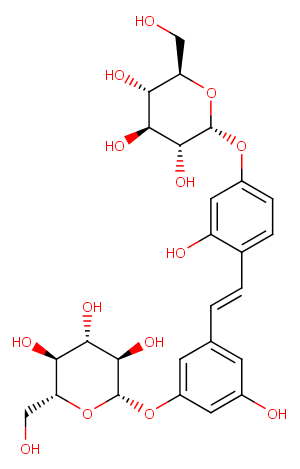Mulberroside A
| Code | Size | Price |
|---|
| TAR-T6S1597-1mg | 1mg | £104.00 | |||||||||||||||||||||||||||||||||||||||||||||||||||||||||||||||||||||||||||||||||||||||||||||||||
| Special offer! Add £1 to your order to get a TargetMol CCK-8 Kit. Read more here. | |||||||||||||||||||||||||||||||||||||||||||||||||||||||||||||||||||||||||||||||||||||||||||||||||||
Quantity:
| TAR-T6S1597-5mg | 5mg | £144.00 | |||||||||||||||||||||||||||||||||||||||||||||||||||||||||||||||||||||||||||||||||||||||||||||||||
| Special offer! Add £1 to your order to get a TargetMol CCK-8 Kit. Read more here. | |||||||||||||||||||||||||||||||||||||||||||||||||||||||||||||||||||||||||||||||||||||||||||||||||||
Quantity:
| TAR-T6S1597-1mL | 1 mL * 10 mM (in DMSO) | £164.00 | |||||||||||||||||||||||||||||||||||||||||||||||||||||||||||||||||||||||||||||||||||||||||||||||||
| Special offer! Add £1 to your order to get a TargetMol CCK-8 Kit. Read more here. | |||||||||||||||||||||||||||||||||||||||||||||||||||||||||||||||||||||||||||||||||||||||||||||||||||
Quantity:
| TAR-T6S1597-10mg | 10mg | £189.00 | |||||||||||||||||||||||||||||||||||||||||||||||||||||||||||||||||||||||||||||||||||||||||||||||||
| Special offer! Add £1 to your order to get a TargetMol CCK-8 Kit. Read more here. | |||||||||||||||||||||||||||||||||||||||||||||||||||||||||||||||||||||||||||||||||||||||||||||||||||
Quantity:
| TAR-T6S1597-25mg | 25mg | £285.00 | |||||||||||||||||||||||||||||||||||||||||||||||||||||||||||||||||||||||||||||||||||||||||||||||||
| Special offer! Add £1 to your order to get a TargetMol CCK-8 Kit. Read more here. | |||||||||||||||||||||||||||||||||||||||||||||||||||||||||||||||||||||||||||||||||||||||||||||||||||
Quantity:
| TAR-T6S1597-50mg | 50mg | £430.00 | |||||||||||||||||||||||||||||||||||||||||||||||||||||||||||||||||||||||||||||||||||||||||||||||||
| Special offer! Add £1 to your order to get a TargetMol CCK-8 Kit. Read more here. | |||||||||||||||||||||||||||||||||||||||||||||||||||||||||||||||||||||||||||||||||||||||||||||||||||
Quantity:
| TAR-T6S1597-100mg | 100mg | £589.00 | |||||||||||||||||||||||||||||||||||||||||||||||||||||||||||||||||||||||||||||||||||||||||||||||||
| Special offer! Add £1 to your order to get a TargetMol CCK-8 Kit. Read more here. | |||||||||||||||||||||||||||||||||||||||||||||||||||||||||||||||||||||||||||||||||||||||||||||||||||
Quantity:
Prices exclude any Taxes / VAT
Overview
Regulatory Status: RUO
Shipping:
cool pack
Storage:
-20℃
Images
Documents
Further Information
Bioactivity:
1. Mulberroside has nephroprotective, hypoglycemic, and antidiabetic effects. 2. Mulberroside A is a glycosylated stilbene of oxyresveratrol; thus, the deglycosylation of Mulberroside A resulted in enhanced inhibition of melanogenesis. 3. Mulberroside A has anti-inflammatory antiapoptotic effects. by decreasing the expressions of tumor necrosis factor-α (TNF-α), interleukin (IL)-1β, and IL-6 and inhibiting the activation of NALP3, caspase-1, and nuclear factor-κB and the phosphorylation of extracellular signal-regulated protein kinases, the c-Jun N-terminal kinase, and p38.
CAS:
102841-42-9
Formula:
C26H32O14
Molecular Weight:
568.528
Pathway:
Proteases/Proteasome; Immunology/Inflammation; Apoptosis
Purity:
0.9905
SMILES:
OC[C@H]1O[C@H](Oc2ccc(C=Cc3cc(O)cc(O[C@@H]4O[C@H](CO)[C@@H](O)[C@H](O)[C@H]4O)c3)c(O)c2)[C@H](O)[C@@H](O)[C@@H]1O
Target:
TNF; Tyrosinase; Interleukin
References
Wang C P , Zhang L Z , Li G C , et al. Mulberroside a protects against ischemic impairment in primary culture of rat cortical neurons after oxygen-glucose deprivation followed by reperfusion[J]. Journal of Neuroscience Research, 2014, 92(7):944-954.



